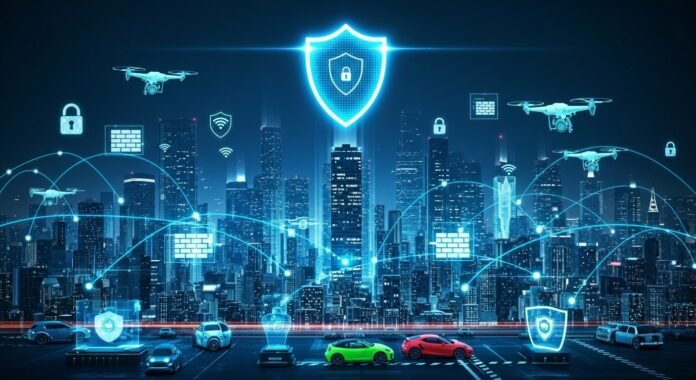Cybersecurity for IoT and Smart Cities is crucial to protect data, privacy, and critical infrastructure from rising cyber threats and vulnerabilities.
A Look at IoT and Smart Cities
IoT is the large network of physical objects that get interconnected by sensors, software, and the internet to collect data and share it. It is projected that by 2030, there will be over 32 billion IoT devices worldwide, and these will be within households, business premises, and infrastructures. Smart cities combine IoT data and automation to enhance the quality of city life through better energy consumption, traffic control, garbage collection, emergency care, etc.
These technologies enable things to become more efficient, new and easy to use, but also accommodate the attack by cybercriminals. Bad actors can use every connected device to access systems, steal data, sabotage or cause issues.
Important Cybersecurity Problems for Smart Cities and the Internet of Things
1. Making the Attack Surface Bigger
IoT devices are regularly deployed in large numbers across large regions, and hence, they are prone to security vulnerabilities. Most IoT devices lack fundamental security features as a more traditional IT system does, making them easy targets. Due to this interconnectivity, a hacked IoT device, such as a security camera, can give the hackers entry to bigger networks controlling and managing smart cities services.
2. No Standardization
Perhaps the most difficult aspect is that no uniform security guidelines exist on smart city infrastructure and IoT devices. Various manufacturers use different protocols and security systems and hence it is difficult to secure all things in a similar manner. This fragmentation complicates the protection of ecosystems containing devices belonging to different vendors.
3. Weaknesses in Devices
Common security holes include weak or default passwords, outdated firmware and unsecure methods of communication. Approximately every fifth IoT device is still using the default passwords, and this is what hackers are using to their own advantage. Additionally, two out of five IoT breaches occur due to IoT devices being exposed to known exploits due to software that has not been updated.
4. Malware and Ransomware
IoT devices can be ransomed, or the functions of various devices can be blocked by viruses. In smart cities such attacks could halt vital services or loot personal data which would be extremely harmful to safety and economy.
5. Botnets and DDoS Attacks
Without appropriate security of the IoT devices, they can be turned into botnets such as Mirai that increases the strength of distributed denial-of-service (DDoS) attacks and can shut down websites or network infrastructure. Over a third of all DDoS attacks is currently being carried out by IoT botnets, making services highly inaccessible.
6. Risks to Data Privacy and Confidentiality
There is a lot of data that IoT devices continuously collect (personal, financial, location, etc). Without proper encryption and access controls, this sensitive data may be stolen, used to commit financial fraud or spying. Stealing personal data is a higher priority among IoT breaches over 25% of the time.
7. Threats from Inside and from the Government
Advanced state-sponsored attacks and threats committed by people who employ the state infrastructure are good to happen in smart cities and other vital infrastructures. Such individuals might attempt to disrupt urban activity, steal intellectual property, or spy on individuals.
8. Risks to Physical Security
IoT brings cybersecurity to the realm of physical security. Hacked smart locks, connected vehicles, or security cameras may allow individuals to gain access without authorization, steal items, or endanger lives.
Best Practices and Ways to Keep Things Safe
Making and Controlling the Life Cycle of Secure Devices
- It requires manufacturers to provide security during the very creation of their products by utilizing hardened hardware, secured boot processes, and secure storage.
- Implement strict identity control methods such as unique device identifier and multi-factor authentication.
- Ensure that patches and firmware updates are performed on a regular basis to address security holes promptly.
- Turn off or change the default credentials before you can deploy it.
Network Segmentation and Zero Trust
- Use segmentation to ensure that IoT device networks do not interfere with critical IT infrastructure.
- Implement a Zero Trust network where no trust is assumed and authentication and authorization must occur at each access point.
- Secure Data over the Internet through firewalls, VPNs, and encrypted channels of communication.
Continuous Surveillance and Identifying Abnormalities
- Identify activity on devices or networks which is not common using AI-powered behavioral monitoring.
- Monitor all the connected devices with unified asset discovery tools to identify any not being managed or behaving suspiciously.
- Deploy intrusion detection and intrusion prevention systems which can be utilized in a diverse range of IoT environments.
Privacy and Data Protection
- Encrypt data when it is being sent as well as when it is stored using powerful protocols such as AES-256 and TLS.
- Only collect the required information by applying the concepts of data reduction.
- Establish access controls and tracking systems to prevent individuals from accessing information they are not supposed to and facilitating auditing.
Incident Recovery and Response Planning
- Plan in detail the response to IoT and smart city incidents.
- Periodically perform security drills and act like you are being attacked.
- Store backups and system snapshots to be able to quickly get back on your feet in case of a ransomware or malicious attack.
Collaboration and Standardization Efforts Among Stakeholders
Everyone in the industry must collaborate to develop security standards, guidelines and certification programs in the IoT and smart city devices. Governments, manufacturers and service providers must collaborate to ensure that rules are stronger and promote best practices.
Better Security New Technologies That Improve the IoT Security
- AI and Machine Learning: These technologies allow discovering threats before they occur, automatically responding, and modifying defenses according to device behavior.
- Blockchain: Keeps data secure to manage the identities of devices and ensure the safety and decentralization of communications.
- Zero-Knowledge Proofs and Privacy-Preserving Protocols: Trust but reduce potential threat of disclosing data.
Why Cybersecurity is Important for Smart Cities
Running critical services, such as electricity grids, traffic lights, water supply, and emergency response is a large component of what makes smart cities operate. The consequences of a cyberattack are horrific, as it can result in endangering people or halting the economy. Cybersecurity must be well established so that citizens trust the government, operations are not interrupted, and rules are adhered to.
Conclusion
The area of cybersecurity of IoT and smart cities is evolving constantly and must address a very broad set of complex threats. The emergence of IoT devices allows hackers to intrude easier and the fact that there is no standard security and hardware vulnerabilities available makes it even more hazardous. To secure smart city infrastructure, you must have a multi-layered approach. This involves the designing of secure devices, network segmentation, ongoing monitoring of networks, responding to network incidents in a comprehensive manner, and collaboration in controlling them.



